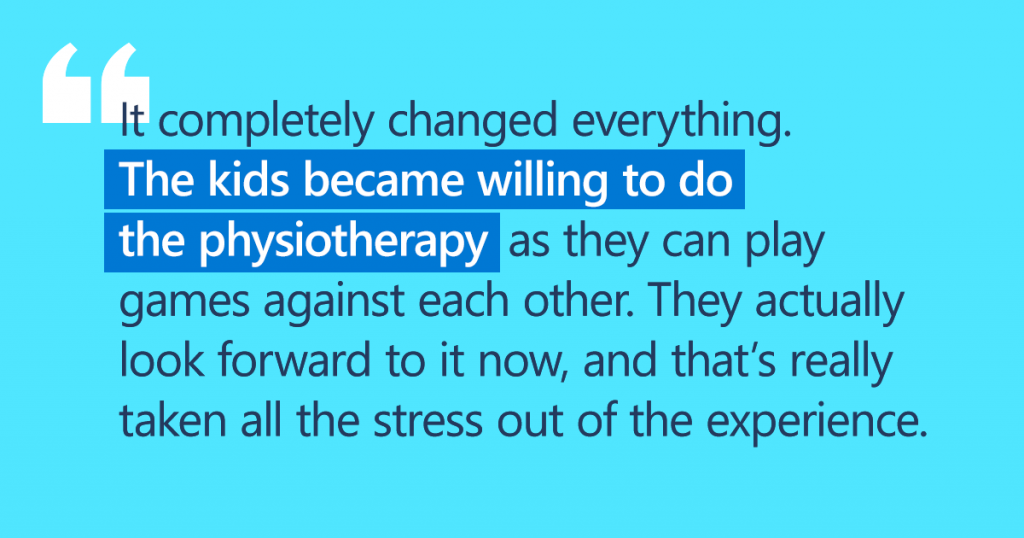
How responsible AI enhances cystic fibrosis treatment

 We’re going to be sharing a story every week for the 12 weeks of summer, showing you how healthcare organisations are using technology to transform patient outcomes and increase productivity. For the seventh blog in the series, Kemera Reuben looks at how a collaboration between UCL, Great Ormond Street, and Microsoft led to Project Fizzyo – and helped modernise cystic fibrosis treatment for children.
We’re going to be sharing a story every week for the 12 weeks of summer, showing you how healthcare organisations are using technology to transform patient outcomes and increase productivity. For the seventh blog in the series, Kemera Reuben looks at how a collaboration between UCL, Great Ormond Street, and Microsoft led to Project Fizzyo – and helped modernise cystic fibrosis treatment for children.
This is a story of how the responsible use of artificial intelligence, analytics, and connected devices radically transforms cystic fibrosis treatment…
Around 100,000 people in the world have cystic fibrosis (CF). Since the condition was identified by Dorothy Andersen over 80 years ago, treatment has improved. But, even today, people born with the condition have an average a life expectancy of just 40 years.
CF is a genetic disorder that affects multiple organ systems in the body. It’s usually lung disease, though, that shortens life expectancy. Mucus blocks up airways in the lungs, creating the ideal environment for infection and inflammation. These cycles of infection and inflammation ultimately damage the lungs so much that transplantation becomes the only therapeutic option.
As a result, treatment for people with cystic fibrosis is time-consuming therapy every day. On top of antibiotics, anti-inflammatory medication, mucus thinners, and bronchodilators, they also need to clear their lungs by doing physiotherapy.
Project Fizzyo leads the charge for change
That’s where Project Fizzyo comes in.

A research collaboration between University College London, Great Ormond Street Hospital, and Microsoft, the project ‘gamifies’ physiotherapy through innovative technology. This helps make the cystic fibrosis treatment more enjoyable for young people, while collecting valuable, reusable analytics.
Explaining how the project began, Professor Eleanor Main, Programme Director at UCL, explained:
“We worked with engineers and computer scientists from UCL, Microsoft, and Great Ormond Street Hospital to build electronic chips for airway clearance devices and a secure and sustainable data transfer platform. We also designed computer games that are played by breathing through the chipped airway clearance device, to try and make the cystic fibrosis treatments less boring and more enjoyable.”
And the results were incredible.
“It completely changed everything,” one mother, whose child tried it, claimed. “The kids became willing to do the physiotherapy as they can play games against each other. They actually look forward to it now, and that’s really taken all the stress out of the experience.”

Big data and machine learning methods to recognise patterns
By using innovative big data and machine learning methods, the Project Fizzyo team explored patterns, associations, and interactions between physiotherapy behaviours at home and clinical outcomes for young CF sufferers. They’re even studying whether gaming during cystic fibrosis treatments will make them easier to do more regularly.
“The project is producing an exceptionally large and complex dataset,” Dr Tempest van Schaik, a Microsoft data scientist, said. “We’re empowering clinical experts to make sense of it all by using scalable cloud technology, and by introducing cutting-edge machine learning techniques.”
The future of cystic fibrosis treatment

In the long-term, Project Fizzyo hopes to understand more about the most effective airway clearance treatments. Big data sets like this may eventually lead to clinicians predicting when infections are likely to happen, so children can receive treatments earlier.
This kind of work has the potential to revolutionise the way care is delivered. It allows us to evaluate the very real effects of medical interventions like physiotherapy. In the future, too, we might see it facilitate personalised and evolving care plans for children as they grow.
Treating cystic fibrosis with future technology
Many new developments in the field of cystic fibrosis treatment are limited to the effects the disease has on the lungs. However, while lung complications are the most severe symptom, we’re finally starting to see the healthcare industry look more closely at CF’s effects on other organs, such as the bowels, pancreas and liver.
At the University Medical Center Utrecht, researchers are using cells from CF patients to develop miniature organoids that replicate the structure of different tissues. This technology could yield results that are more accurate at predicting how the human body reacts under different conditions and drugs. It may also help prescribe personalised treatment to patients with rare forms of CF.
There’s still a long way to go before this kind of practice becomes part of the standard care. But, as scientists learn more about the disease’s complexity, the future looks brighter for patients. Experts have made considerable improvements over the last decade. Finally, they believe that responsible, technological developments can further change patients’ lives in the years to come.
Find out more
Discover how to maximise your AI opportunities
AI in healthcare: recognising symptom patterns in COPD patients
The chatbot opportunity in healthcare
About the author
 Kemera Reuben is a Microsoft Account Executive with a passion for how technology can improve lives and make a positive impact. She believes that we’ve barely scratched the surface of what technology will help us achieve, and the dramatic improvements it’ll bring to the healthcare sector. Through Microsoft’s healthcare customers, Kemera is fortunate enough to see how technology is saving lives, improving care, and transforming the patient experience.
Kemera Reuben is a Microsoft Account Executive with a passion for how technology can improve lives and make a positive impact. She believes that we’ve barely scratched the surface of what technology will help us achieve, and the dramatic improvements it’ll bring to the healthcare sector. Through Microsoft’s healthcare customers, Kemera is fortunate enough to see how technology is saving lives, improving care, and transforming the patient experience.




